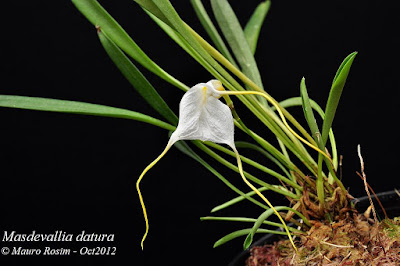Masdevallia datura is native to Bolivia. These plants were found near the village of Inquisivi, which is located between La Paz and Cochabamba. The natural environment is the mountain rain forest at an altitude of 2400 to 2800 m...
Masdevallia datura also called as The Datura-Like Flower Masdevallia, is a species of the genus Masdevallia. This species was described by Carlyle August Luer & Roberto Vásquez in 1983. The species epithet is derived from the Hindu word dhatura, meaning giant, but this species was named datura based on the similarity of the flower to those of the genus Datura (Solanaceae or nightshade family).
IDENTIFY MASDEVALLIA DATURA
Masdevallia datura is native to Bolivia. These plants were found near the village of Inquisivi, which is located between La Paz and Cochabamba. The natural environment is the mountain rain forest at an altitude of 2400 to 2800 m. This species was first collected for herbarium specimens in the Yungas of Bolivia in the latter part of the 19th century by H. H. Rusby, but it was not published until 1983 by Luer and Vásquez. The site where the Luers and Vásquez collected the species in 1982 (elevation 2500 m) has been totally destroyed by expansion of the small community in the area.
It is a small sized, cold growing epiphytic species, which reaching 13-20 cm in height, with slender, erect, 2.0-4.5 cm long ramicauls enveloped basally by 2 to 3 thin, tubular sheaths carrying a single, apical, coriaceous, erect, dark green, narrowly elliptical, long petiolate, acute apically, 11-16 cm long leaf that has the base narrowly cuneate into the petiole.
The Datura-Like Flower Masdevallia blooms in the spring a slender, suberect, 6 to 9 cm long, single flowered inflorescence arising from low on the ramicaul with a bract near the base and a tubular floral bract that carries the large, showy, heavily scented flower at mid-leaf. The flowers are 8.25cm in diameter. The spectacular flower features a large, white, funnel-shaped sepaline tube, with equally long, slender tails. The basic color of the outer petals of the perianth is white, but they are slightly saturated with a yellow color. They also have bright yellow venation running from the base, with small brown spots on each side. The inner petals of the perianth, the lip and the prone are also white.
MASDEVALLIA DATURA CARE AND CULTURE
Cultural information should only be used as a guide, and should be to be adapted to suit you. Your physical location; where you grow your plants, how much time you have to devote to their care, and many other factors, will need to be taken into account. Only then can you decide on the cultural methods that best suit you and your plants.
Light:
Masdevallia datura needs a light level of 8000-15000 lux. The light should be filtered and dispersed, and the plants should not be exposed to direct sunlight. Strong air movement should be ensured all the time. These plants grow best placed within the range of humid, cool air current near the outlet of the cold humidifier.
Temperature:
It is a plant with moderate thermal requirements. In summer, when the average temperature is 23-25 ° C and night 12 ° C , with daily amplitude of 12-13 ° C . In winter, the average daily temperatures are 23-24 ° C and night 1-4 ° C , with an amplitude of 20-22 ° C .
Humidity:
The Datura-Like Flower Masdevallia needs the humidity of 60-65% in summer and early autumn, falling to 45-50% for most of the year.
Substrate, growing media and repotting:
Masdevallia datura grow well also mounted on pieces of tree ferns or cork, but in the summer it requires high humidity and daily watering. In the case of such attached plants, during the dry and hot periods it may be necessary to water several times a day.
They can also be grow in pots. In this case, they use a substrate quickly draining excess water, which, however, contains substances that retain a certain amount - such as chopped sphagnum moss or perlite. Wood charcoal is also often added to ensure the air permeability of the substrate and protection against acidification. It is recommend repotting the plants every year.
Watering:
For most of the year, rainfall is low or medium. The plants in cultivation should be damp, and between the next waterings should only slightly dry out. In late autumn, waterings should be gradually reduced.
Fertilizer:
If the plants grow in sphagnum moss, tree fern fibers or osmunda fern roots, they should be fertilized every 3-4 weeks 1/4-1/2 of the recommended dose of orchid fertilizer during the period of strong growth. If they are grown in a bed of pine bark, fertilization can be applied every 1-2 weeks.
At the beginning of the year, when the plants grow actively, instead of fertilizers with equal proportions NPK, you can use fertilizers with high nitrogen content. In contrast, in late summer and autumn, you can use high phosphorus fertilizers to stimulate the plants to flower.
Rest period:
Masdevallia datura need less water in the winter, especially if they grow under the conditions of a dark, short day that occurs in moderate latitudes. You can let the plants dry between the next watering, but you must not let the plants stay dry for a long time. Fertilization should be limited or should be completely abandoned until spring, when stronger watering resumes.















COMMENTS